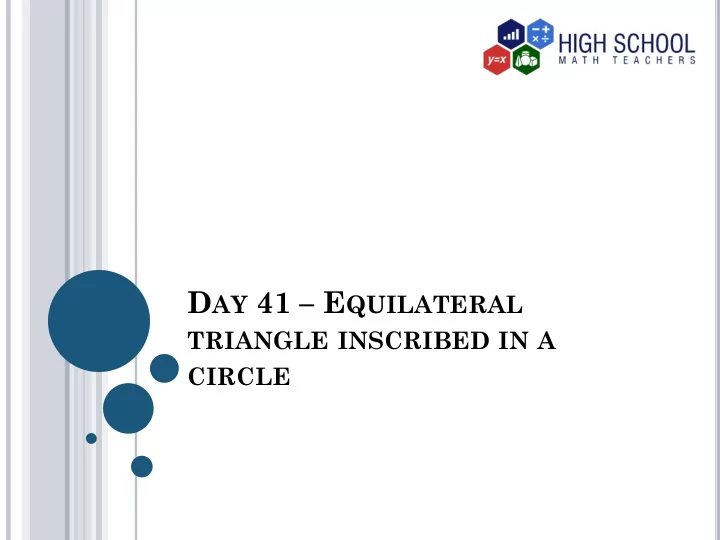

D AY 41 – E QUILATERAL TRIANGLE INSCRIBED IN A CIRCLE
I NTRODUCTION Some plane figures can draw inside a circle in such a way that the vertices touch the edge of the circle. For instance, a triangle can be drawn inside a circle such that all its three vertices touch the edge of the circle. The common types of triangles can be drawn inside a circle; however, in this lesson, we are going to learn how to construct an equilateral triangle inside a circle.
V OCABULARY Equilateral triangle A triangle that has all the three sides equal and all the three angles equal. Inscribed triangle A triangle is drawn inside another plane figure such that the vertices of the triangle touch the edge of the plane figure, in this case, a circle.
C ONSTRUCTING AN EQUILATERAL TRIANGLE INSCRIBED IN A CIRCLE We are going to construct an equilateral triangle inside a circle in such a way that its vertices touch the edge of the circle using a straightedge and a compass. When a triangle is constructed inside a circle as described above, we say that the triangle has been inscribed in the circle. The method used is based on the basic idea that a turn is equivalent to 360° and an equilateral triangle has all angles measuring 60°. Therefore, the circle is divided into six arcs each equivalent to 60° .
To construct an equilateral triangle inscribed in a circle: 1. We use a compass to construct a circle with center O, of any convenient radius as shown below. O
2. Using a straightedge, we draw a line segment from the center to the edge of the circle as shown below. We then label the other endpoint of the segment P as shown below. OP is the radius of this circle. P O
3. Using the same radius, we use point P as the center and make an arc to intersect the circle. We label this intersection point Q as shown below. Q O P
4. Using the same radius, we use point Q as the center and draw an arc that intersects the circle at point R as shown below. Q R O P
5. We continue to use the new intersection points constructed as the new centers with the same radius until the last arc intersects point P as shown below. We draw a total of 6 arcs. Q R O P
6. We construct the sides of the equilateral triangle by selecting any intersection point and joining it to the third intersection point using a straightedge as shown below. We repeat this process until the inscribed equilateral triangle is formed as shown below. Q R O P
Example Draw a circle of a suitable radius using a compass and construct an equilateral triangle inscribed in the circle with the help of a straightedge.
Solution We draw a circle of any convenient radius and use the same radius to draw six arcs at equal intervals as shown below.
We join the arcs with straight lines using a straightedge in the format shown below to form the inscribed triangle.
HOMEWORK Use a pair of compasses and a straightedge to construct the largest possible equilateral triangle that will fit in the circle with center O shown below. O
A NSWERS TO HOMEWORK The largest equilateral triangle drawn is the inscribed equilateral triangle. We use the center to get the radius.
THE END
Recommend
More recommend